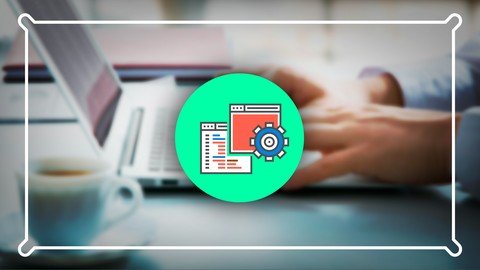
Google Kubernetes Engine (Gke) - A Beginner'S Guide
Last updated 9/2021
MP4 | Video: h264, 1280x720 | Audio: AAC, 44.1 KHz
Language: English | Size: 1014.13 MB | Duration: 2h 57m
Every expert was once a beginner
What you'll learn
A very high level overview of Docker
Different aspects of Google Kubernetes Engine (GKE)
Different services of Google Cloud Platform that might be used together with Google Kubernetes Engine
How to deploy a micro service based application in Kubernetes Engine
Different approaches of deploying applications in Kubernetes Engine
How to monitor an application deployed in Kubernetes cluster using Google's monitoring tool
How Kubernetes & Google Kubernetes Engine works in real life projects
How to Deploy a Stateful Application within the Kubernetes Cluster using GKE
How to Deploy a Slack Chat Bot Application within the Kubernetes Cluster using GKE
Requirements
Basic understating of Linux command will help
This course is not about Kubernetes itself. Therefore, I expect you to have some basic understanding of various Kubernetes objects such as pods, deployments, services and so on.
As this course is mostly about Google Kubernetes Engine, you must need an active account on Google Cloud Platform so that you can do enough practices while going through this course
Description
Hello Everyone, welcome to the course of "Google Kubenetes Engine for Absolute Beginner".Throughout the course I will try my level best to illustrate various aspects of Google Cloud Platform and Google Kubernetes Engine (GKE) in an easy way with lots of examples and assignments that will not only help you to understand the underlying concepts but also make you confident to apply the knowledge that you will gain in this course.The course is divided into two main sections. The first section is all about highlighting some core features of Google Cloud Platform (GCP) where as the another section will mainly focus on one of the core services of GCP which is Google Kubernetes Engine(GKE).In the first section, you will start the course with an introductory overview of GCP console that can be used to navigate various services of GCP. Then, you will go through the usages of GCP's command line interface known as Google Cloud shell. you will get to know how to use this Google cloud shell to interact with various GCP services. Then you will see how to create virtual machines using both GCP console and Google Cloud Shell. You will also see in the first section, how to distribute traffic across a number of servers using load balancers.In the following section, where you get to know various features of Google Kubernetes Engine, will focus on deploying microservices in a Kubernetes cluster on Google infrastructure. You will also get to know various ways of deployment in Kubernetes cluster. you will also see the usage of various docker commands from a very high level. You will also see in this section the process of setting up and implementing continuous delivery pipeline with Jenkins in Google Kubernetes engine.
Overview
Section 1: Introduction
Lecture 1 Course Overview
Lecture 2 Features of Google Kubernetes Engine (GKE)
Section 2: Google Cloud Platform (GCP)
Lecture 3 Introducing Google Cloud Platform (GCP)
Lecture 4 Introducing Google Cloud Shell
Lecture 5 Creating Virtual Machine in GCP
Lecture 6 Load Balancing in GCP
Section 3: Deploying Application with Google Kubernetes Engine
Lecture 7 Docker in a Nutshell
Lecture 8 Introducing Google Kubernetes Engine (GKE)
Lecture 9 Deploying a Microservice Application on Google Kubernetes Engine
Lecture 10 Rolling Update Vs Blue Green Deployment Vs Canary Deployment
Lecture 11 Implementing Continuous Delivery Pipeline on GKE with Jenkins-X
Section 4: Assessments: Deploying a Multi-Tier Web Application
Lecture 12 Tasks
Lecture 13 Assignment One: Building a Docker Image
Lecture 14 Assignment Two: Deploying the Application
Lecture 15 Solution: Deploying the Application
Section 5: Cluster Administration
Lecture 16 Section Overview
Lecture 17 Managing GKE Cluster
Lecture 18 Configuring GKE Cluster
Lecture 19 Resizing GKE Cluster
Lecture 20 Managing Node Pools
Lecture 21 Cluster Upgradation
Lecture 22 Cluster Autoscaling
Lecture 23 Deleting GKE Cluster
Section 6: Bonus Lectures
Lecture 24 Monitoring the Cluster with Kubernetes Dashboard
Section 7: Bonus Project - 1 : Deploying Wordpress Application into GKE
Lecture 25 Project Overview
Lecture 26 Provisioning Kubernetes Cluster
Lecture 27 Persistent Volume (PV) & Persistent Volume Claim (PVC)
Lecture 28 Google Cloud SQL
Lecture 29 Deploying WordPress Application
Section 8: Bonus Project - 2 : Deploying a Slack Chat Bot into GKE
Lecture 30 Project Overview
Lecture 31 Slack Workspace
Lecture 32 Chat Bot Application
Lecture 33 Building Docker Image
Lecture 34 Deploying the Chat Bot into GKE
Section 9: Conclusion
Lecture 35 Learning Resources
Lecture 36 Thank You
Developers who want to deploy their applications in to Google Kubernetes Engine (GKE),DepOps engineers who want to move into Kubernetes from their traditional infrastructure,Anyone who want to explore various features of Google Kubernetes Engine
Screenshots
https://uploadgig.com/file/download/0Eec2ea3BAd85327/Google_Kubernetes_Engine_GKE_A_Beginners_Guide.part2.rar

